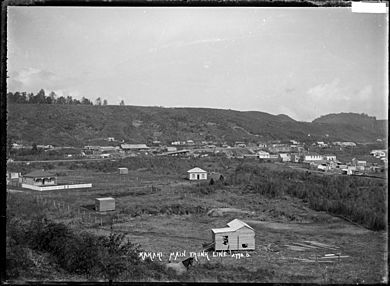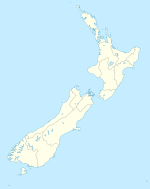Kakahi, New Zealand facts for kids
Kakahi (Māori: Kākahi) is a small town in New Zealand, located near the Whanganui River. It started as a town where people cut down trees for wood. Its name, Kākahi, comes from the Māori word for a type of freshwater mussel found in New Zealand.
Contents
Exploring Kakahi's Location
You can reach Kakahi by driving on State Highway 4. The main railway line of the North Island Main Trunk also goes through the town, crossing the Kakahi Stream on a bridge. There used to be a train station here from 1904 to 1978.
The Whanganui River and Whakapapa River meet about 1.5 kilometers east of Kakahi. If you go down the Whakapapa River from Te Rena Road, you'll find amazing glowworms! They live along the steep banks where the road cuts through the hills.
Kakahi's Past: A Look Back
Early Māori Life
Kakahi has a long history of Māori settlement. There were once four fortified pā sites, which were like strongholds. Around the 15th century, a group called Ngāti Hotu was defeated here by Whanganui Māori in a famous battle known as "the battle of the five forts."
In February 1862, a person named James Coutts Crawford traveled through this area. He crossed the Whakapapa River and camped near Te Rena.
Kakahi in the 1900s
In the last century, Kakahi was a busy sawmill town. There were four timber mills around the town, which cut down trees, mostly tōtara wood. Many special tram lines were used to move the timber.
Kakahi also had three churches, a hotel (which later burned down), a boarding house, and a pool hall. When the Kakahi Primary School closed, it had a big effect on the number of people living in the town. The Kakahi General Store and post office, and the new Kakahi Hall, were important parts of the community.
In 1906, the Ngāti Tūwharetoa people and the Tongariro Timber Company made a deal. They agreed to build a 40-mile (64 km) railway line from Kakahi to Pukawa, connecting to Lake Taupō. This was in exchange for the company being able to cut down trees on a large area of land. However, this railway line was never built, and the government eventually took over the Tongariro Timber Company.
In 1923, a man named Lake Falconer Ayson, who was the Chief Inspector of Fisheries, visited Kakahi. He released half a million baby Atlantic salmon into the Whanganui River, Whakapapa River, Kakahi Stream, and other nearby streams. These baby fish were successfully hatched at the Kakahi hatchery.
Modern Kakahi
The Kakahi Town Hall was originally built by one of the timber companies. It was used as a cinema for silent movies and a dance hall. It still has its original piano, a special fireproof room for film projectors, and even copper pipes in the ceiling for its old lighting system!
Other old commercial buildings in Kakahi still stand, but they are no longer used for their original purpose. These include the butcher shop, the baker (which still has its old bread oven), the original post office, and a blacksmith's stables.
The bakers in Kakahi were famous for delivering their hot bread all over the region, even to distant logging camps. The saying "The best thing since sliced bread" actually came about because many small bakers couldn't afford the expensive machines to slice bread. This was one reason why some bakeries, like the one in Kakahi, eventually closed.
Kakahi is also known for its iconic general store, which is one of the last few remaining general stores in New Zealand. It is run by Manu Lala, whose family has owned the store since 1937. He is a very important part of the community.
The Kakahi area is also a popular spot for trout fly fishing.
Marae: Meeting Places
Kākahi Marae and its meeting house, called Taumaihiorongo, were built in 1913. This is a special meeting place for the Ngāti Tūwharetoa group called Ngāti Manunui. A Catholic church with a bell tower stands next to the marae. In October 2020, the government provided money to help upgrade this marae and four others.
Te Rena Marae and its meeting house, Hikairo, are located near Kakahi. This is a meeting place for another Ngāti Tūwharetoa group called Ngāti Hikairo. In October 2020, the government also provided funds to upgrade this marae and seven others nearby.
Sports and Fun in Kakahi
|
||||
|
The local sports teams in Kakahi usually wear blue and gold uniforms. The Domain, which is a sports field north of the village, was once home to the Kakahi field hockey team. In the 1970s, it also hosted regular motocross races and rodeo competitions. These events helped raise money for community activities. Around the Domain, you can still see parts of an old racing bicycle track, though some of it was washed away during a flood in the 1950s.
Education in Kakahi
Kakahi School opened in 1910 because the area was growing economically. It was a primary school for students from Year 1 to 8. In 2015, there were nine students enrolled, but by 2016, there were no students left. Kakahi School officially closed on April 15, 2016.
Famous People from Kakahi
- Keith Chapple (1944–2005) was a former president of the Royal Forest and Bird Protection Society of New Zealand, an organization that protects nature.
- Peter McIntyre (1910–1995) was an official New Zealand war artist during World War II. He had a holiday home in Kakahi and even published a book of paintings about the area in 1972 called Kakahi New Zealand.



